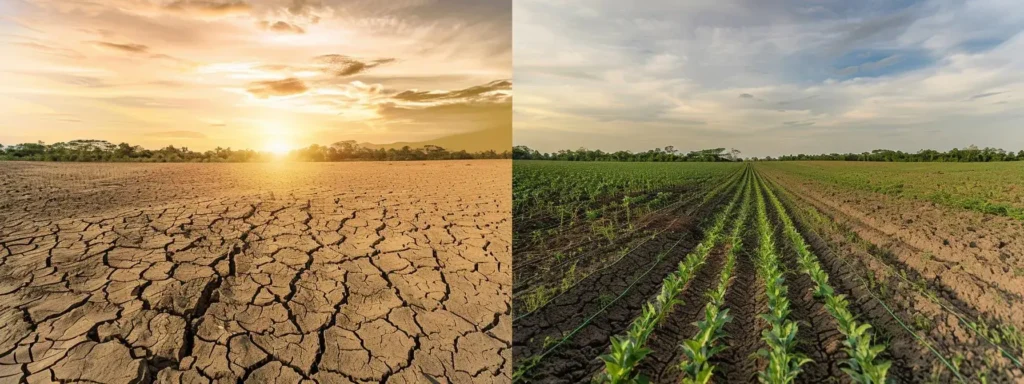The Power of Smart Irrigation in a Drying World
As droughts grow longer and water becomes more precious, smart irrigation is transforming how America grows its food. From California to Texas, farmers are turning to intelligent water-saving solutions that reduce waste, cut costs, and help crops thrive—even under extreme climate stress.
In this blog, we explore how smart irrigation systems are empowering U.S. farmers to survive and succeed in a drying world.
What Is Smart Irrigation?
Smart irrigation uses advanced technology to manage water more efficiently in farming and landscaping. Instead of watering on a fixed schedule, these systems adjust based on:
🌱 1. Soil Moisture Levels
What it means:
This measures how much water is currently in the soil around plant roots.
Why it matters:
If the soil already has enough moisture, there’s no need to water. Overwatering can cause root rot, waste water, and increase costs.
How it works in smart irrigation:
Soil moisture sensors are placed in the ground. They detect real-time moisture levels and send data to the irrigation system. The system then decides whether to turn on, delay, or adjust the water flow.
Benefit:
Water is applied only when the soil is dry—never too early, never too late.
☁️ 2. Weather Forecasts
What it means:
This refers to using local weather data—like expected rainfall, temperature, humidity, and wind—to plan watering.
Why it matters:
If rain is coming soon, there’s no need to irrigate now. If it’s going to be hot and dry, the system might increase watering slightly.
How it works in smart irrigation:
The system connects to local weather stations or online forecast services. It automatically adjusts the watering schedule based on upcoming conditions.
Benefit:
Prevents watering before rain, saving water and reducing runoff.
🌾 3. Crop Type and Stage
What it means:
Different crops need different amounts of water. And even the same crop needs more or less water depending on whether it’s just planted, growing, or ready to harvest.
Why it matters:
Watering a young seedling the same way as a mature corn plant leads to waste—or worse, crop damage.
How it works in smart irrigation:
Farmers input crop type and growth stage into the system. The software uses this data to customize irrigation levels.
Benefit:
Each plant gets exactly what it needs—no more, no less.
📡 4. Real-Time Data from Sensors
What it means:
These are various sensors that continuously collect data from the field—like temperature, humidity, soil moisture, and sunlight.
Why it matters:
Conditions change fast. What worked yesterday might not work today.
How it works in smart irrigation:
Sensors send live updates to the irrigation controller. The system uses this real-time data to make on-the-spot decisions—starting, stopping, or adjusting water flow.
Benefit:
Irrigation becomes dynamic and responsive—not based on guesswork or fixed schedules.
By applying water only when and where it’s needed, smart irrigation reduces waste, supports plant health, and lowers utility bills.
Why America Needs Smart Irrigation Now
The U.S. is facing growing challenges in water availability:
- Over 40% of the country is experiencing drought (source: NOAA)
- Agriculture uses nearly 80% of water in western states
- Traditional irrigation systems lose up to 50% of water to runoff and evaporation
In this drying climate, using water wisely isn’t just helpful—it’s essential.
Benefits of Smart Irrigation for U.S. Consumers
1. 💧 Saves Water, Saves Money
Farmers using smart irrigation have reported up to 30–50% water savings. That directly translates to lower costs and more sustainable operations.
2. 🌱 Healthier Crops and Yields
Plants receive the right amount of water at the right time. This reduces disease, improves root health, and boosts productivity.
3. 🌎 Supports Sustainable Farming
Using less water reduces environmental strain and helps preserve local water sources—benefiting both people and ecosystems.
4. 📈 Data-Driven Decision Making
Smart systems offer real-time analytics, allowing farmers to monitor performance, detect issues early, and make better farming decisions.
Popular Smart Irrigation Technologies in the U.S.
Here are some of the most used tools in American agriculture:
- Soil Moisture Sensors – Measure water content at different depths to avoid overwatering
- Drip Irrigation Systems – Deliver water directly to roots, minimizing waste
- Weather-Based Controllers – Adjust watering schedules based on forecasted rain, temperature, and humidity
- Wireless Remote Management – Lets farmers control irrigation from their phones or tablets
Major companies like Toro, Hunter, and Rain Bird offer smart irrigation tools that are now being adopted on farms, vineyards, orchards, and even residential lawns.
Challenges and Considerations
While smart irrigation has major benefits, some challenges remain:
- Upfront cost can be high for small-scale farmers
- Training and maintenance require technical knowledge
- Connectivity may be limited in rural areas
Still, with government rebates, USDA support, and the long-term savings, the investment often pays off within a few seasons.
The Future of Farming with Smart Irrigation
As climate change continues to affect rainfall and weather patterns, intelligent water management will become the norm—not the exception.
Innovations on the horizon include:
- AI-powered water scheduling
- Satellite-based field monitoring
- Fully automated irrigation zones
These systems will help feed a growing population while protecting one of our most limited resources—water.
✅ Frequently Asked Questions (FAQ)
1. What is smart irrigation and how does it work?
Modern irrigation systems use technology like sensors, weather data, and automation to water crops or lawns only when necessary. By adjusting to real-time conditions, they help save water, cut costs, and support healthier plant growth by delivering the right amount of water at the right time.
2. Why is smart irrigation important in drought-prone areas?
In regions facing drought or water restrictions, smart irrigation helps conserve water by preventing overwatering and waste. It ensures every drop counts—making it ideal for places like California, Texas, and Arizona.
3. How much water can smart irrigation save?
Smart irrigation systems can save between 30% to 50% more water compared to traditional systems. These savings come from watering based on real-time data instead of fixed schedules.
4. Are smart irrigation systems expensive?
The initial cost can be higher than basic systems, but smart irrigation often pays for itself through water savings, higher yields, and lower utility bills. Government rebates or agricultural grants can help offset the cost.
5. Can smart irrigation be used for home gardens?
Yes! Many smart irrigation controllers are designed for residential use. Homeowners can use Wi-Fi-connected devices to manage garden or lawn watering remotely through a smartphone app.
6. What are the best smart irrigation tools for farmers in the U.S.?
Popular smart tools include soil moisture sensors, drip irrigation systems, weather-based controllers, and remote management platforms. Companies like Rain Bird, Toro, and Hunter lead in this space.
7. Is smart irrigation good for sustainable agriculture?
Absolutely. It reduces water waste, lowers environmental impact, and supports long-term soil and crop health—making it a key part of sustainable and regenerative farming practices.
Conclusion
The power of smart irrigation in a drying world is clear. It’s saving water, supporting sustainable farming, and helping American growers thrive despite drought and climate pressures.
Whether you’re a farmer, rancher, or conscious consumer, supporting and investing in smart water solutions is one of the best ways to protect our food future.

Nick William is a dedicated travel blogger with a passion for uncovering hidden destinations and sharing authentic experiences from around the world. With a background in digital media and storytelling, he has developed a unique style that combines detailed research, vivid descriptions, and personal insights. His goal is to help readers not only plan their journeys but also connect with the culture, people, and stories behind each place.
When Nick isn’t exploring new cities or trekking off-the-beaten paths, he enjoys capturing moments through photography, reading history books, and sipping coffee while drafting his next adventure. His writing brings destinations to life, making every reader feel like a fellow traveler on the journey.


